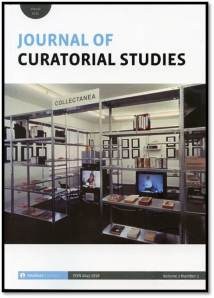Contact:
Jennifer Fisher, Editor, jefish@yorku.ca
Jim Drobnick, Editor, jim@displaycult.com
2013
Bruce Altshuler, Biennials and Beyond – Exhibitions That Made Art History: 1962-2002, Phaidon.
Noriko Aso, Public Properties: Museums in Imperial Japan, Duke University Press.
Audience as Subject, Yerba Buena Center for the Arts.
Susana Smith Bautista, Museums in the Digital Age: Changing Meanings of Place, Community, and Culture, Rowman & Littlefield.
Kirsty Bell, The Artist’s House: From Workplace to Artwork, Sternberg Press.
Hans Belting, Andrea Buddensieg and Peter Weibel, eds., The Global Contemporary and the Rise of New Art Worlds, MIT Press.
Susan Bennett, Theatre and Museums, Palgrave Macmillan.
Andrea A. Burns, From Storefront to Monument: Tracing the Public History of the Black Museum Movement, University of Massachusetts Press.
Ting Chang, Travel, Collecting, and Museums of Asian Art in Nineteenth-century Paris, Ashgate.
Judith Clark and Amy de la Haye, Exhibiting Fashion: Before and After 1971, Yale University Press.
“Curatorial Education,” The Shadow Files #3, de Appel arts centre.
Norman K. Denzin, Indians on Display: Global Commodification of Native America in Performance, Art, and Museums, Left Coast Press.
Gabriele Detterer and Maurizio Nannucci, eds., Artist-Run Spaces, JRP Ringier.
Jennifer Dickey, Samir El Azhar, and Catherine M. Lewis, eds., Museums in a Global Context: National Identity, International Understanding, American Alliance of Museums Press.
Angela Dimitrakaki and Lara Perry, eds., Politics in a Glass Case: Feminism, Exhibition Cultures and Curatorial Transgressions, Ashgate.
Kirsten Drotner and Kim Christian Schroder, eds., Museum Communication and Social Media: The Connected Museum, Routledge.
Pascal Gielen, ed., Institutional Attitudes: Instituting Art in a Flat World, Valiz/Antennae.
Gwangju Biennial Foundation, Shifting Gravity: World Biennial Forum 1, Hatje Cantz.
Neil Harris, Capital Culture: J. Carter Brown, the National Gallery of Art, and the Reinvention of the Museum Experience, University of Chicago Press.
Rodney Harrison, Sarah Byrne and Anne Clarke, eds., Reassembling the Collection: Ethnographic Museums and Indigenous Agency, School for Advanced Research Press.
Jens Hoffmann, ed., Ten Fundamental Questions of Curating, Mousse.
Hong Kal, Aesthetic Constructions of Korean Nationalism: Spectacle, Politics and History, Routledge.
Clare Jacobson, New Museums in China, Princeton Architectural Press.
Benoit Junod, Georges Khalil, Stefan Weber and Gerhard Wolf, eds., Islamic Art and the Museum: Approaches to Art and Archaeology in the Muslim World, Saqi Books.
Cara Krmpotich, Laura Peers and the Haida Repatriation Committee, This Is Our Life: Haida Material Heritage and Changing Museum Practice, UBC Press.
Lisa Lee and Hal Foster, eds., Critical Laboratory: The Writings of Thomas Hirschhorn, MIT Press.
Claudia Lichtenstein, ed., Max Bill’s View of Things/Die Gute Form: An Exhibition 1949, Lars Muller.
Tracey L-D Lu, Museums in China: Power, Politics and Identities, Routledge.
Jean-Paul Martinon, The Curatorial: A Philosophy of Curating, Bloomsbury.
Kylie Message, Museums and Social Activism: Engaged Protest, Routledge.
Andrea Meyer and Benedicte Savoy, The Museum Is Open: Towards a Transnational History of Museums 1750-1940, Walter de Gruyter.
Nina Möntmann, ed., Scandalous: A Reader on Art and Ethics, Sternberg Press.
Sarah J. Moore, Empire on Display: San Francisco’s Panama-Pacific International Exposition of 1915, University of Oklahoma Press.
Paul O’Neill and Mick Wilson, eds., Curatorial Research, Open Editions and de Appel arts centre.
Griselda Pollock, After-affects/After-images: Trauma and Aesthetic Transformation in the Virtual Feminist Museum, Manchester University Press.
Tijana Rakic and Jo-Anne Lester, eds.,Travel, Tourism and Art, Ashgate.
Steven Rand and Heather Felty Kouris, eds., Life Between Borders: The Nomadic Life of Curators and Artists, apexart.
Claire Robins, Curious Lessons in the Museum: The Pedagogic Potential of Artists’ Interventions, Ashgate.
Angelina Russo and Lynda Kelly, Museums, Social Inclusion, and Online Networks, Routledge.
Brenda Schmahmann, Picturing Change: Curating Visual Culture at Post-Apartheid Universities, Wits University Press.
Silke Arnold-de Simine, Mediating Memory in the Museum: Trauma, Empathy, Nostalgia, Palgrave Macmillan.
Alexandra Stara, The Museum of French Monuments 1795-1816: Killing Art to Make History, Ashgate.
Gail Stavitsky, Laurette E. McCarthy and Charles H. Duncan, The New Spirit: American Art in the Armory Sow, 1913, Montclair, NJ: Montclair Art Museum.
Liv Emma Thorsen, Karen A. Rader and Adam Dodd, Animals on Display: The Creaturely in Museums, Zoos, and Natural History, Penn State University Press.
Jeffrey Trask, Things American: Art Museums and Civic Culture in the Progressive Era, University of Pennsylvania Press.
Karen van den Berg and Ursula Pasero, eds., Art Production beyond the Art Market?, Sternberg Press.
John C. Welchman, ed., Sculpture and the Vitrine, Ashgate.
Claire Wintle, Colonial Collecting and Display: Encounters With Material Culture from the Andaman and Nicobar Islands, Berghahn.
Takashi Yoshida, From Cultures of War to Cultures of Peace: War and Peace Museums in Japan, China, and South Korea.
The Journal of Curatorial Studies is an international, peer-reviewed publication that explores the cultural functioning of curating and its relation to exhibitions, institutions, audiences, aesthetics and display culture. The journal takes a wide perspective in the inquiry into what constitutes “the curatorial.” Curating has evolved considerably from the connoisseurship model of arranging objects to now encompass performative, virtual and interventionist strategies. While curating as a spatialized discourse of art objects remains important, the expanded cultural practice of curating not only produces exhibitions for audiences to view, but also plays a catalytic role in redefining aesthetic experience, framing cultural conditions in institutions and communities, and inquiring into constructions of knowledge and ideology.


